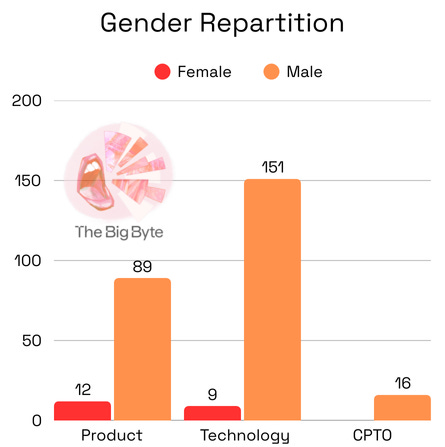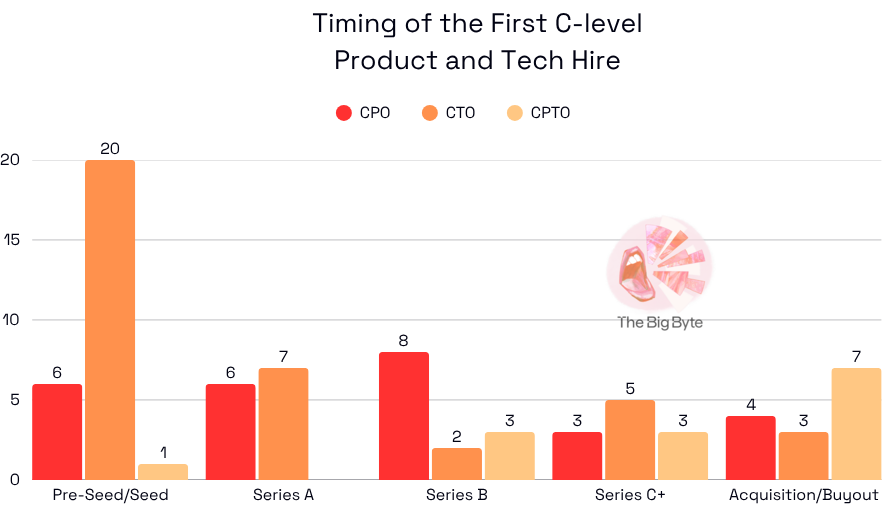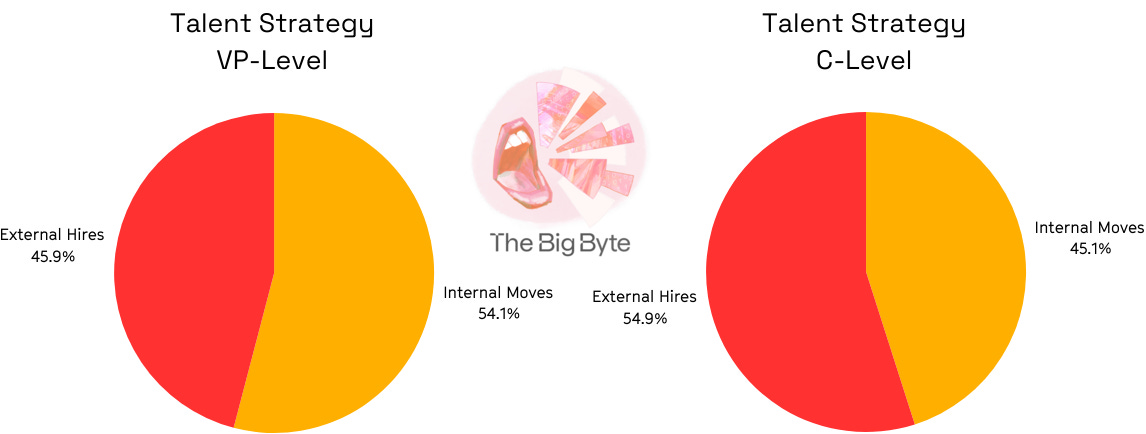Benchmarks of Product/Tech Leadership in Growth-Stage B2B SaaS, DACH
We aimed to uncover the blueprint behind their success as well as what it really takes to lead product and tech in some of DACH's most ambitious SaaS companies.
Product and Tech talent are the ones building the very foundation of every B2B SaaS success story. They build what gets sold and fix what breaks. In scaling B2B SaaS companies, they often make up as much as 40% of the total headcount. Clear proof of how important they are to a company’s growth.
We've compiled the report on Product and Tech leadership across the DACH region, building the ultimate benchmarking guide for growth-stage B2B SaaS companies. Whether you're a founder or CEO shaping your leadership team, an investor backing one of these ventures, or a product or tech leader planning your next move, this one’s for you.
We’ve mapped out the profiles of these leaders, exploring their seniority, gender, geographic origins, years of experience, career paths, timing, tenure, churn, compensation, and more. We aimed to uncover the blueprint behind their success as well as what it really takes to lead product and tech in some of DACH's most ambitious SaaS companies.
This report was compiled together with the Product Practice at The Big Search. If you're interested in leadership and talent trends, looking to hire an executive leader, or simply want to discuss the findings, feel free to reach out 👉 andrei@thebigsearch.com
💡 Why DACH Matters Right Now
The DACH region stands as one of the most vibrant hotspots for B2B SaaS growth, attracting founders, investors, and clients. With VC investment in the region reaching $2.8 billion in Q1 2025, DACH is the second-largest recipient in Europe, just behind the UK.
Similarly, DACH is a popular destination for PE investors. The region ranks as the second most valuable market in Europe by total EV managed by PE firms, with €304B under management. To give you a sense of the region's pulling power, some leading firms like Permira and Advent International allocate over 30% of their European assets to the DACH market.
Last but not least, the region is the top choice for many B2B SaaS companies wishing to expand into Europe, and its robust ecosystem is setting the pace for innovation and growth.
🔎 The 100 B2B SaaS DACH Companies mapped
We analyzed 100 B2B SaaS companies in the DACH region with 200–1,000 FTEs, each backed by at least $10 million in venture capital or by private equity. We tried to map the full leadership market to provide a representative sample and identified 277 individuals at C- and VP-level across Product, Design, Technology, Engineering, R&D, and AI. We excluded Head-of and Director-level positions to maintain a clear focus on senior commercial leadership.
🧑💼 How Many Product and Tech Leaders Do We Have?
Note: We categorized CPTO separately due to its scope, encompassing both product and tech functions, distinct from either category alone.
We see a clear lean toward the Tech function, which may be due to CEOs often playing the de facto product leader role.
Still, 14% of the analyzed companies didn’t have any C-level Product or Tech leadership at all, and 29% didn’t have VP/SVP roles at all. In both cases, there were more junior leaders present (VPs or Directors/Heads of).
👥 Unsurpisingly Male
Female leaders are most represented in product roles, making up 11.9% of leadership positions, while their presence drops to around 6% in tech and engineering roles.
This disparity underlines (if further proof were needed) a pipeline issue within the tech industry, characterized by a limited number of women advancing in technical careers and achieving senior leadership positions, especially so in the DACH SaaS ecosystem.
📅 Timing - When Do Companies Hire Their First C-Level Product Executive?
48.7% of initial C-level hires occurred during later funding stages (Series B or beyond), which is lower than what we found in our commercial report.
We attribute this lower figure primarily to the high number of CTOs who joined during the pre-seed or seed stages. This is often due to either (1) one of the founders taking on the CTO role or (2) one of the first engineers hired to build the platform, and eventually growing into the position as the company matures. What’s interesting, though, is the emergence of CPTO roles in the later stages, around Series B+.
🤝 Internal Promotion vs. External Hiring
We found a slight preference for filling VP-level roles through internal promotions. However, when it comes to the C-suite, boards seem to lean towards external leaders who have already guided a SaaS company through growth stages.
🚀 Step-up, Side-Step, or Step-Down?
When stepping up to VP-level roles, individuals frequently advanced from Director/Head positions; for C-level positions, candidates typically had prior experience at the VP or SVP level.
Most side-steps at the C-level (excluding direct moves from identical positions) included CTO ←→ CPO or CTO/CPO → CPTO. We also came across unexpected moves from roles such as Chief Development Officer, Chief Strategy Officer, or Chief Commercial Officer.
At the VP-level, moves downward involved transitions from SVP or C-level roles. At the C-level, downward moves occurred from the CEO position.
➡️ Vertical vs. Lateral Moves
Although cross-functional mobility within product and tech roles does exist, most leaders continue to progress within their original disciplines, with only 7.2% transitioning from another product or tech function.
Additionally, 19.5% of leaders moved into their current roles directly from outside product and tech, including functions such as GTM, general management, strategy, and operations.
Unsurprisingly, the low number of lateral moves comes down to two things: (1) the skill sets needed for Product and Tech are quite different, even if the teams work closely together, and (2) role-specific expectations at the top. As leaders move up, companies look for expertise in one domain, which makes switching tracks less common.
⌛ Tenure - How Long Do Leaders Stay?
While the data may suggest that CPTOs have short tenures, it's important to consider that this role is relatively new. Notably, 63% of CPTOs in our analysis were appointed from 2024 onwards, and none have left yet.
Product leaders' lower tenure isn't surprising, since volatility in product leadership isn't a new topic within the industry.
Next, we explored whether prior B2B SaaS experience could influence leadership tenure, and it does: leaders with previous B2B SaaS experience tend to have shorter tenures, particularly at the C-level (3.8 years compared to 4.7 years). We assume this is because these leaders tend to be in higher demand and thus receive more opportunities.
❌ Product/Tech Leadership Is a High-Churn Game
Since 2020, 54.5% of leaders have left their roles, with an average annual churn rate of 12.2%.
57% left within 24 months and 80% within 48 months
Surprisingly, 60% of departures were internal moves. On top of that, they also had an average shorter tenure (2.9 years compared to 4.3 years for external hires).
We didn’t see that one coming, but our best take on what’s driving the high churn rate among internal hires: (1) It could be a story of them having built and scaled a function successfully in one B2B SaaS company, only to get headhunted to do it all over again somewhere else; (2) Companies assume internal hires require less onboarding and coaching than external hires, leaving them to manage the scaling phase independently; (3) Salary friction, where increased responsibilities and scope are not matched by corresponding salary increments.
📈 Years of Experience to the Top
In our sample, CPTOs have the highest average years of experience. That comes as no surprise, considering they oversee both product and technology functions, which demands a solid foundation in both areas.
⬆️ How Long Does it Take to Reach the C-level Title?
The longer average journey to a CPTO role is primarily due to two things: the need for extensive experience across both product and tech functions, and the recent introduction of the role (All the CPTOs mapped were appointed to the role from 2020 onwards). So, individuals moving into CPTO positions often possess lengthy career backgrounds.
📜 Where do Tech and Product Leaders Come From?
44.3% transitioned directly from a startup or scaleup environment, 39.9% from corporate settings, and 15.8% from other contexts, including small agencies, universities, or institutions.
Regarding industry backgrounds, 35.4% arrived directly from B2B SaaS companies, 14.1% from B2C industries, and 12.3% from consulting or finance/banking sectors.
Looking at career-wide B2B SaaS experience, 52% had prior experience in the industry at some point previously in their career.
🏢 Corporate and Startup/Scaleup Experience
These numbers align closely with the ones in our commercial and CEO analyses - leaders cutting their teeth in the corporate world before leaping into startup or scaleup settings. The 12% who lack both experiences: this includes talents with an agency background (e.g. consulting or design), freelancers, and university graduates who joined their company directly and advanced internally.
📍 How Many are German Speakers and Where Do they Come From?
72.9% originate from within DACH, with 85.7% being Germans.
The most represented non-DACH nationalities are Indian, Russian, and American.
90% of leaders joined from companies already based in DACH.
Berlin clearly stands out, accounting for 29% of total leaders' prior workplaces, reflecting its position as Germany's largest labor market and a hub for engineering and technology. Outside the DACH region, no other international hub stands out, pointing to a hyper-local hiring strategy focused on local talent.
Two decades of SaaS development in the region have produced numerous leaders capable of managing product and tech teams in scaling companies. Consequently, the domestic talent pool is now big enough, and local supply is no longer a bottleneck.
Additionally, only 39.7% of leaders have experience working outside the DACH region. International experience, while crucial for CEOs and commercial leaders focused on global expansion, may be less needed for tech and product leaders whose primary responsibilities revolve around product enhancement and technical excellence rather than market expansion strategies.
💶 Compensation Study: Who Wins What?
The CPTO function offers the most competitive compensation at the C-level, with a median base salary of €200k and median OTEs of €250k. At the VP-level, the Technology function offers the highest compensation with a median base salary of €150k and median OTEs of €180k.
Combining these insights with the commercial compensation study reveals the perceived value of different functions during a company's scaling phase: a notable emphasis on sales and customer acquisition and less investment in product and technology functions.
⚡ Conclusion: What Surprised Us The Most?
Female Leadership Representation: Female leaders at the VP and C-level constitute less than 10% of total headcount, revealing a significant pipeline issue and the need for stronger initiatives to encourage female leadership development.
Emerging CPTO Role: ALL the CPTOs were hired post 2020, most often during scaling phases. You can really see how the role has only recently emerged but quickly took an important place in the B2B SaaS industry, bridging product and tech as companies move into more mature stages.
Cross-functional mobility: Fewer than 10% of leaders made lateral moves between Product and Tech roles, which suggests it’s harder than expected to switch functions as you move up the ladder.
Impact of prior B2B SaaS experience: Leaders with previous B2B SaaS experience often have shorter tenures, reflecting their high market demand and frequent mobility.
Churn & internal moves: 60% of departures were internal moves, likely influenced by limited support, inadequate onboarding, salary discrepancies, or the inherent volatility of product roles.
Hyper-local hiring strategy: ~90% of leaders joined from companies within the DACH region, indicating the robustness of the local talent pool. and companies' confidence on local recruitment strategies to scale product and tech teams.
If you enjoyed this piece, consider subscribing. We’ve got some more interesting research pieces lined up.
And if you're interested in a confidential conversation about Product/Tech hiring👉 andrei@thebigsearch.com
If you wish to access our exclusive data file with over 270 leaders in product and technology functions at 100 DACH B2B SaaS companies, simply drop a message in the comments, and we’ll send it to you. 📥

















